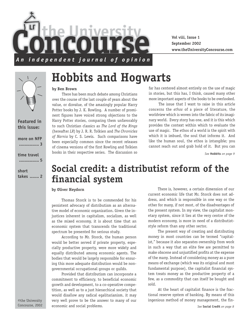Social credit: a distributist reform of the financial system
by Oliver Heydorn
Thomas Storck is to be commended for his persistent advocacy of distributism as an alternative model of economic organization. Given the injustices inherent in capitalism, socialism, as well as the mixed economy, it is about time that an economic system that transcends the traditional spectrum be presented for serious study.
According to Mr. Storck, the human person would be better served if private property, especially productive property, were more widely and equally distributed among economic agents. The bodies that would be largely responsible for ensuring this more adequate distribution would be non-governmental occupational groups or guilds.
Provided that distributism can incorporate a commitment to efficiency, to beneficial economic growth and development, to a co-operative competition, as well as to a just hierarchical society that would disallow any radical egalitarianism, it may very well prove to be the answer to many of our economic and social problems.
There is, however, a certain dimension of our current economic life that Mr. Storck does not address, and which is responsible in one way or the other for many, if not most, of the disadvantages of the present system. In my view, the capitalist monetary system, since it lies at the very centre of the modern economy, is more in need of a distributist-style reform than any other sector.
The present way of creating and distributing money in most countries can be termed “capitalist,” because it also separates ownership from work in such a way that an elite few are permitted to make obscene and unjustified profits at the expense of the many. Instead of considering money as a pure means of exchange (which was its original and most fundamental purpose), the capitalist financial system treats money as the productive property of a few, as a commodity that can itself be bought and sold.
At the heart of capitalist finance is the fractional reserve system of banking. By means of this ingenious method of money management, the financiers are able to extort enormous amounts of money in interest payments from their customers. I say ‘extort’ because the profits that are generated by this process are largely unearned.
Fractional reserve banking works in the following way: Smith goes into bank A and deposits 1000 dollars in cash. Bank A is only required to keep a small amount of this money in its reserves, say 3-10%, while the rest can be loaned out. Let’s say that Jones wants to borrow 900 dollars from bank A in order to purchase a used car. Let’s assume further that Jones does not want to buy the car in cash, but prefers to offer the salesman a cheque. When Jones goes to bank A with his request, and the bank agrees to grant him a loan for 900 dollars, the bank will not loan out the 900 dollars it has on deposit from Smith; rather, it will duplicate this 900 dollars by writing a cheque for Jones. This is because credit money, i.e., money that must be paid back with interest, is just as valid as paper money or coins as a medium of exchange. Thus, where there was only 1000 dollars in cash at the beginning of the process, the bank has now added an additional 900 dollars to the money supply by means of the fractional reserve system. When Jones hands his cheque over to the salesman from whom he purchases the car, and the latter deposits it in bank B, the whole process of generating new credit and hence new money is repeated once again.1
Indeed, it is estimated that ~95% of the money supply of a modern economy is created ex nihilo by financial institutions in this manner.2 The problem with the fractional reserve system is that although it cost the financiers little or nothing to create this new money, they nevertheless insist on interest payments. The result is usury, traditionally understood not as the charging of an exhorbitant amount of interest, but as the charging of any interest whatsoever on a non-productive loan. Now a loan may be non-productive in two different ways. A loan may be non-productive in the sense that it is not going to be used to finance profitable production, or non-productive in the sense that the loan is not the product of a cost-generating process. Loans that are the product of the fractional reserve system do not, by themselves, entail any significant cost for their producers, therefore the charging of interest on these loans is usurious.
In addition to the intrinsic injustice of such a system, this way of creating and supplying money has some very harmful consequences. Whenever a banker creates a loan and demands to be paid back with interest, he only introduces the principal into the monetary supply; he does not introduce any money to cover the interest payments which may, in the long run, amount to more than the principal itself. The result is that under the current financial set-up there is a chronic lack of money that artificially limits both production and consumption. This, in turn, leads to escalating personal, corporate, and government debts, wasteful economic growth, environmental degradation, the inadequacy of health and educational services, social breakdown, unnecessary financial stresses, and so on. On account of its essential nature, as well as its nefarious consequences, it is about time that the fractional reserve system be rejected as immoral.
I would like to suggest, therefore, that before we see to the introduction of a distributist economy in Mr. Storck’s sense, we should first consider a reformulation of the present financial system in accordance with distributist principles. For the most important kind of property that needs to be more justly and hence more widely distributed is money, for money, as the universal medium of exchange, provides its holders with the necessary means for obtaining any good or enjoying any service.
The doctrine of Social Credit, first developed in the early part of the last century by the Scottish Engineer C.H. Douglas, may be regarded as one such distributist alternative to the fractional reserve system of money creation and distribution. The proposal consists of a number of policies that are designed to work in tandem. In the first place, fractional reserve banking would be replaced by full reserve banking, so that the banks could no longer produce most of a country’s money supply for personal gain. Instead, a National Credit Office would be charged with the responsibility of ensuring that the money supply is always equal to the productive capacity of the economy, in such a way that purchasing power is sufficient to liquidate supply. The new money that would be created by the NCO would be regarded as a social service, hence the term “Social Credit.” This means, in turn, that it would be introduced into the economy debt and interest free. Some of this new money would be used to finance government expenditure on health, education, infrastructure, defense and so on (thus eliminating the need for taxes); some of it would be distributed to each citizen in the form of a social dividend that would guarantee everyone a minimal revenue (thus eliminating destitution and the more severe forms of poverty); and some of it would be used to finance the retail sector while lowering the prices of goods and services for consumers (thus allowing for the recalibration of the whole system and the prevention of inflation.)3
Unfortunately, it would be beyond the scope of this article to give the Social Credit doctrine the more precise exposition and defence that it deserves. I briefly present it here in the hopes that more people would come to recognise that there are viable alternatives to a capitalist monetary system, alternatives which may, if adopted in time, mean the difference between—as Douglas says—another retreat into the dark ages, or the emergence into a day of such splendor as could never have been imagined.
M. Oliver Heydorn Graduated from the FUS MA Philosophy program. He is currently a student in the doctoral program at the International Academy of Philosophy in Liechtenstein.
- Cf. http://www.laleva.cc/economia/money.html ↑
- Cf. http://www.douglassocialcredit.com ↑
- By financing the retail sector through this ‘just price mechanism’, a balance in the money supply would be maintained: new money would be injected at the rate of production, while old money would be retired from circulation at the rate of consumption. ↑


